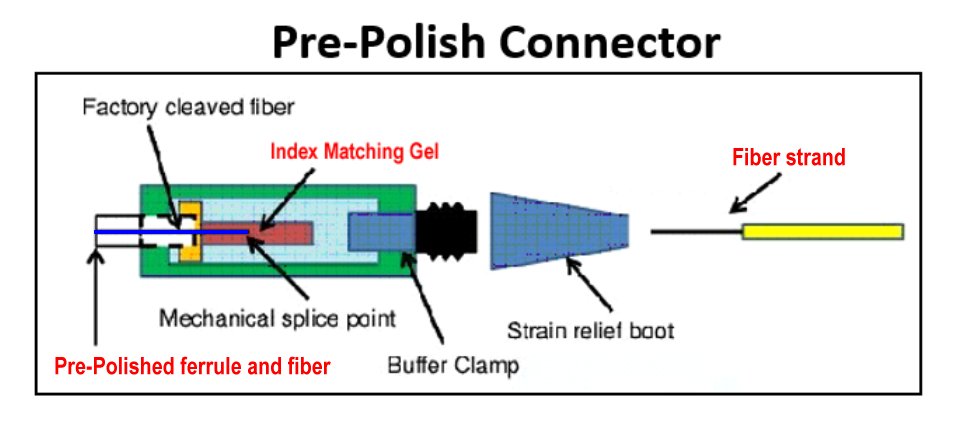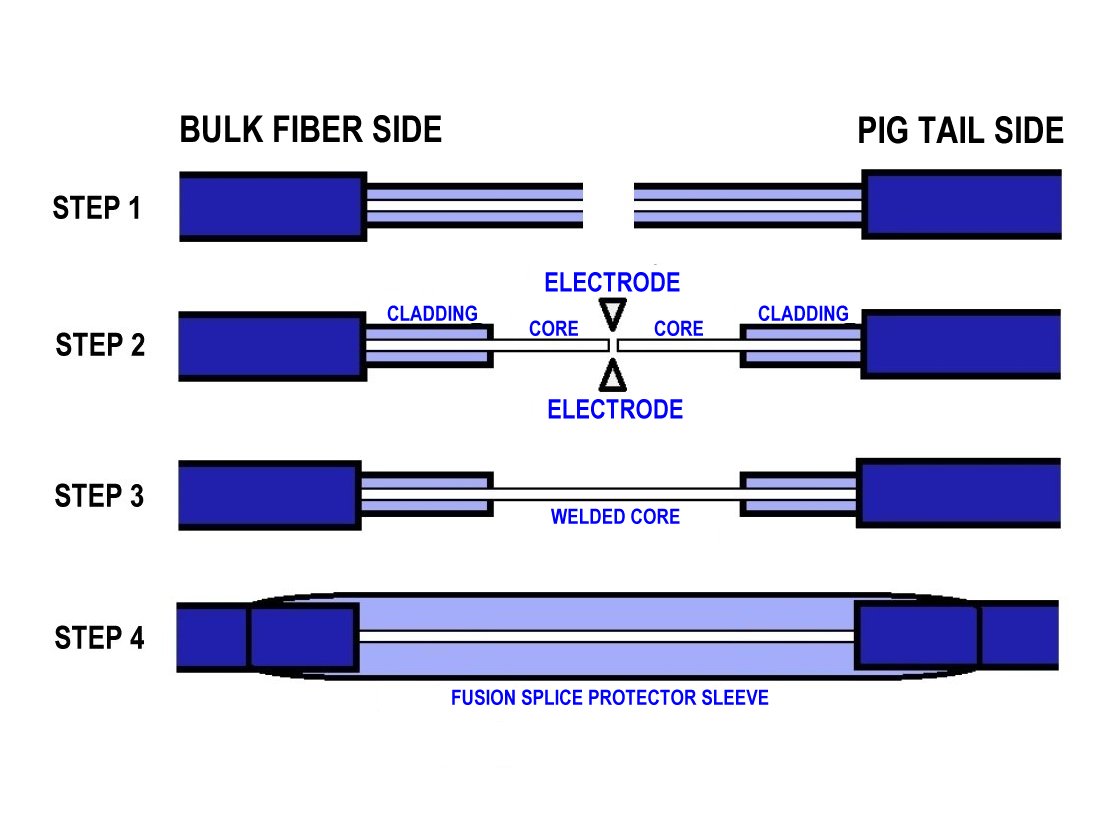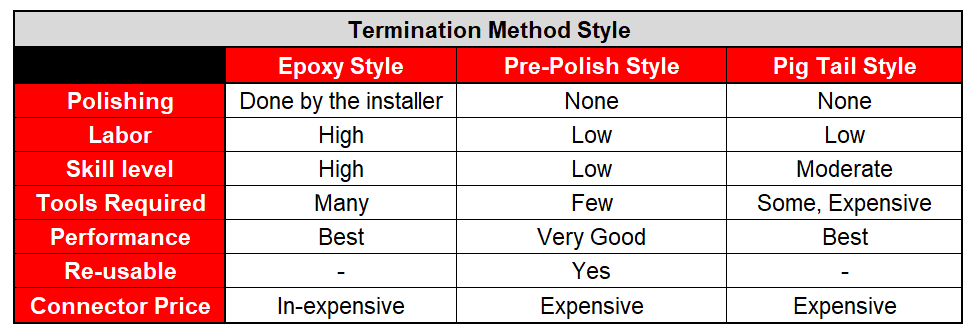Today, many data center installations use some form of fiber cabling. This fiber cable can range from several hundred fiber cable assemblies connecting equipment together within a data cabinet to large bundles of bulk fiber trunk cables running from the data center out to remote areas of the building or campus.
Fiber cable assemblies are typically available in a wide range of lengths with fiber connectors terminated, polished, and tested at the factory. Not much end-user support is needed beyond “fiber end face cleaning,” which is good practice before using any fiber assembly. But, for bulk fiber trunk runs, after the bulk cable is pulled, technicians need to install connectors before using the fiber cable.
Many end users fear that installing fiber connectors on bulk fiber requires a high level of skill to be done correctly. Several years ago this was true, but today it may not be the case, because there are some other ways to terminate bulk fiber.
Typically, there are three common ways to install and terminate a fiber connector on the end of a bulk fiber cable run. These three methods use “Epoxy Style Connectors,” “Pre-Polished Style Connectors,” or “Fiber Optic Pigtails.” Each of these methods has several advantages as well as some disadvantages. Users can choose the best termination method for their application.

This fiber connector termination method is very good because the fiber connectors are very inexpensive, plus it keeps and maintains a continuous strand of glass all through the connector. The downside to this method is that it takes a great skill level and a lot of time to do one fiber connector termination.
A much easier and faster way to terminate a connector onto a fiber strand is using pre-polished connectors, so the installer does not have to polish the fiber connector. Polishing is usually where a lot of the labor, skill, and time occurs. Terminating these pre-polished connectors typically requires less skill because the connectors are polished at the factory. Pre-polished connectors are sometimes referred to as “field termination connectors,” because they are used to make quick repairs or terminations out in the field.
Looking at the image below, notice the small pre-polished piece of fiber already in the connector shown in blue. To terminate, the user just needs to strip and clean the fiber strand to a specific length set by the manufacturer and insert it into the rear of the connector until it touches the piece of pre-polished fiber where it meets the index matching gel inside the connector. The index matching gel is a liquid material used to reduce signal reflections where two fibers meet. At this point, depending upon the design of the pre-polished connector, you will just need to make a light crimp or twisting of the connector to lock the fiber in place for extended use. This completes the termination.
When terminating pre-polished style connectors, use a good quality cleaver so the mating of the fiber strand inside the connector is good.
A major advantage of many pre-polished fiber connectors is that they can be reused. Depending upon the connector design, on many of these pre-polished connectors you can ”unlock” the fiber stand from the connector and reuse it. This is good in case you don’t correctly strip the fiber strand to the proper length or you don’t “seat” the fiber correctly inside the connector. A disadvantage of these connectors is that they are much more expensive than traditional epoxy-style fiber connectors, because they have been polished at the factory.
In recent years, the technique of “fiber splicing” has become very common for terminating fiber connectors. Fiber splicing is a method where you get two strands of fiber glass and fuse them together to create a single fiber strand. Historically, fiber splicing was used to make repairs if a strand of glass was damaged. But recently, installers started to use fiber splicing as a method to terminate fiber connectors with fiber optic pigtails.
A fiber optic pigtail is a single strand of fiber 1 or 2 meters in length with a terminated connector only on one side. The connector on the pigtail is fully polished and ready for use. Installers will buy the pigtails with the connector and glass they need for their application.
Installers just need to invest in a fiber optic splicer along with a good quality cleaver. Splicing the pigtails to the bulk fiber cable saves times by eliminating the time- and labor-intensive of epoxy curing and polishing procedures from traditional fiber terminations. Also, splicing gives the best optical performance similar to traditional epoxy-style connectors. The fiber splicer uses an integral electrode that creates an arc and welds the glass together where the two strands meet.
Fiber splicing is becoming more common, since the price of fiber splicers has dropped greatly over the past several years.
Fiber splicing using pigtails generally follows these steps:
STEP 1 – Gather your bulk fiber and pigtail strands. Slide a protective sleeve on one end.
STEP 2 – Strip and cleave each fiber strand as instructed and place in the fiber splicer. The splicer will automatically align and prepare the two strands for splicing.
STEP 3 – Start the splicing process. This usually only takes a few seconds. Now the bulk fiber strand and pigtail strand will be welded together.
STEP 4 – Slide up the protective sleeve to safeguard your newly welded fiber.
Each termination method has advantages as well as some disadvantages. These can vary from cost of connector and equipment used, time, labor, optical performance, and skill level. 
Traditional epoxy-style terminations typically require a highly skilled technician. They give the best performance because there is a continuous strand of glass through the connector. The cost of these connectors are usually very inexpensive. Normally, lots of time and labor is needed to make each individual fiber connector termination.
Pre-polished style terminations typically don’t require much user skill and give good performance, but the cost of the connectors are very expensive since the polishing is done at the factory. Time and labor is usually very minimal. These are typically used to make quick terminations “out in the field” and not done in a mass production application.
Pigtail fiber splicing typically requires a moderate skill level technician. Expensive equipment must be purchased and used to perform any splicing. Performance is extremely good since the connectors are equivalent to epoxy style connectors and use a continuous strand of glass. The cost of the pigtails are usually expensive since all polishing was done at the factory, but time and labor costs are minimal since splicing is done quickly.

Product Engineer
Steve Molek has 27 years’ experience in the cabling and connectivity data communication industry. He started his career as a Technical Support Representative and now works as a Project Engineer for Black Box. As a Product Engineer, his primary focus is evaluating and testing all new cabling and connectivity products for sale by Black Box and training our inside technical support and sales teams. Steve also works directly with our domestic and international OEM suppliers as well as several nationally recognized third-party testing labs. Steve holds a B.S. degree in Mathematics and Computer Science from California University of Pennsylvania and an MBA from Waynesburg University.